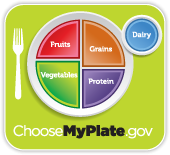Investing in Family: The New "My Plate" Nutrition Guidelines
The old "Pyramid" nutrition guidelines are pretty much obsolete now as the government puts forth the new "My Plate" guidelines. The old system, it seems, was confusing, and the "My Plate" system should help clear things up. What does this mean for you and your family as you strive to meet nutritional needs? Let's take a look.
"My Plate" in a Nutshell
"My Plate" is an easier-to-follow method used to reach nutritional needs. The chart used is simplified, and at a glance, moms, dads and kids alike can decide if their meal is nutritious. The design now features a large circle, which is divided into sizes for fruits, vegetables, meats and grains. A smaller circle shows a dairy serving, like milk, above the plate.
The divisions of the plate show that vegetables should be the largest serving, protein the next largest, and fruits and grains mark each of the smaller serving sizes. Basically, it encourages people to load up half their plate with fruits and veggies and the other half with protein and starches.
Overall, the concept is good for a glance, but the "My Plate" system is lacking in one regard: it doesn't tell you how big the plate is supposed to be. As we all know, our American dinner plates have become super-sized over the years, so if we all went by "My Plate" using our actual dinner plates, we'd still probably be getting too much food.
"My Plate" in Depth
To counter the issue with plate size, though, the government has set forth a ton of other information, including how many servings we need of each and how big an actual serving is. The info is good but almost overwhelming. Thankfully, the new MyPlate.gov website allows people to set up their own accounts to track their nutrition and calories, all with the additional benefits of reaching goals like weight loss, pregnancy health and children's health.
It is possible to track this all without using the website, if so desired. At its simplest, the average American adult needs 2,000 calories per day with 150 minutes of exercise per week. We need to take in 5.5 oz. of meat, two servings of fruit, three servings of veggies, six servings of grains and three servings of dairy. This leaves 250 calories per day for treats or additional servings of whatever healthy foods we please.
My Review
When I looked over the "My Plate" system at the beginning of my pregnancy, I knew from experience that "My Plate" was suggesting that I eat too much. But that's just me, because I have a super-low metabolism. As for my opinions on the system overall (for other people), I think each person is an individual and should take the new nutrition guidelines with a grain of salt. If your metabolism is low, like mine, it may be important to make adjustments that will fit in your lifestyle, in your health needs, and in your weight goals.
- Login to post comments
-







AverageJoe wrote:
Wed, 08/15/2012 - 19:13 Comment #: 1Interesting. I'm trying to do this currently. I'd like to cut back on the amount of meat I eat. Lots of good info.
Christa Palm wrote:
Mon, 09/03/2012 - 17:39 Comment #: 2Good luck, Joe! When you actually measure out the daily requirement of 5.5 ounces of meat, it is surprisingly small and therefore easy to accomplish.